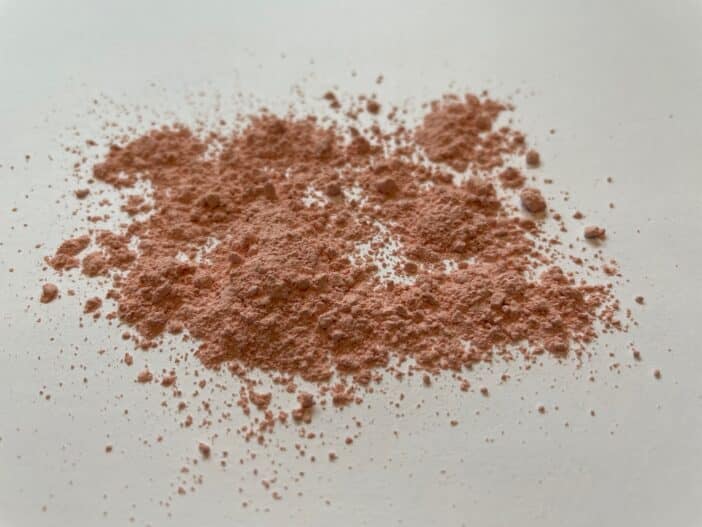Calamine Powder

The English term calamine is derived from the Latin term “calamina”, which in turn is derived from the Greek word “Kadmeia”. In ancient Greece, Kadmeia was the name of the hill on which the legendary city of Thebes was located. The Kadmeian soil was considered to be very fertile and valuable: presumably, the name of the active ingredient calamine powder is based on its visual resemblance to the soil.
Calamine is in fact a powder with a delicate pink hue. It is a mixture. The largest part is made up of zinc oxide, an almost snow-white powder that has some very positive properties. According to the specification in the USP (the U.S. Pharmacopeia), calamine powder must have a zinc oxide content of at least 98 percent.
However, in a cosmetic application, the light-colored calamine powder would leave an unsightly white film on the skin. That is why the zinc oxide is mixed with iron(III) oxide. Iron(III) oxide naturally has an intense red color and, with a content of about 0.5 percent, provides the slight pink coloration of calamine powder. Thus, the iron(III) oxide is used exclusively for skin-colored tinting. But why and what is calamine used for anyway?
The effect of calamine powder on the skin
The zinc oxide contained in the mixture has a strong anti-inflammatory, astringent, and antibacterial effect. Inflamed and acute pimples heal better and faster with the application of calamine powder, unsightly scarring can be prevented. It also effectively prevents the formation of new blemishes. Thanks to the mentioned pink coloration, calamine powder also has a very good covering effect, which means that the impurities are cleverly concealed and thus almost invisible. In the case of very severe acne, however, the substance may not be sufficient for treatment. Here, for example, a combination with other proven anti-pimple active ingredients such as salicylic acid is recommended. For occasional blemishes and pimples, however, calamine is a very good and, above all, tolerable choice.
In addition, the powder is ideal for sensitive and irritated skin. The soothing, slightly cooling and anti-itching effect proves especially useful for rashes or sunburn. Since zinc oxide also has a drying effect, calamine powder is also an excellent solution for weeping skin conditions and eczema. Accordingly, calamine powder can be used as a mild astringent and has cooling properties.
Where should calamine powder be used?
Calamine powder can be very well integrated into serums, creams, and masks. When treating more severe blemishes, spot application is recommended, meaning the cream is applied directly to the pimple(s). If the formula is enriched with antioxidants and vitamins, the corresponding product provides excellent overall skin protection in everyday life, which at the same time prevents pimples.
By the way, besides the powder, there is also calamine lotion, which has a similar composition. It is said to have been appreciated by the ancient Egyptians because it could alleviate the accompanying symptoms of mosquito bites. The World Health Organization (WHO) has also classified the lotion as an “essential medicine” for the treatment of itching.
Fact Sheet Calamine Powder
INCI: calamine
CAS number: 8011-96-9
Definition: a mixture of zinc oxide and iron(III) oxide
Description: a light pink powder
Effect: astringent, antiseptic, drying, antipruritic, soothing
Calamine for high quality cosmetic products
Pink calamine powder is a real secret weapon against pimples and skin impurities. It is also very suitable for treating mild weeping skin inflammations and rashes. Calamine is of mineral origin and is considered to be very well tolerated and recommended. It is also used in numerous medical products. We are happy to support you in the development of modern, effective, and sophisticated formulations.
Sources:
Effectiveness of calamine lotion as an adjunctive therapy to mometasone furoate ointment in the treatment of infant eczema: A retrospective study.; Medicine (Baltimore). 2022 Sep 2;101(35):e30237.
Zinc therapy in dermatology: a review.; Gupta M, Mahajan VK, Mehta KS, Chauhan PS. Dermatol Res Pract. 2014;2014:709152.
A novel treatment of diaper dermatitis in children and adults.; Dall’Oglio F, Musumeci ML, Puglisi DF, Micali G.J Cosmet Dermatol. 2021 Apr;20 Suppl 1(Suppl 1):1-4
Functionalized zinc oxide microparticles for improving the antimicrobial effects of skin-care products and wound-care medicines.; Chen J, et al. Biomater Adv. 2022.